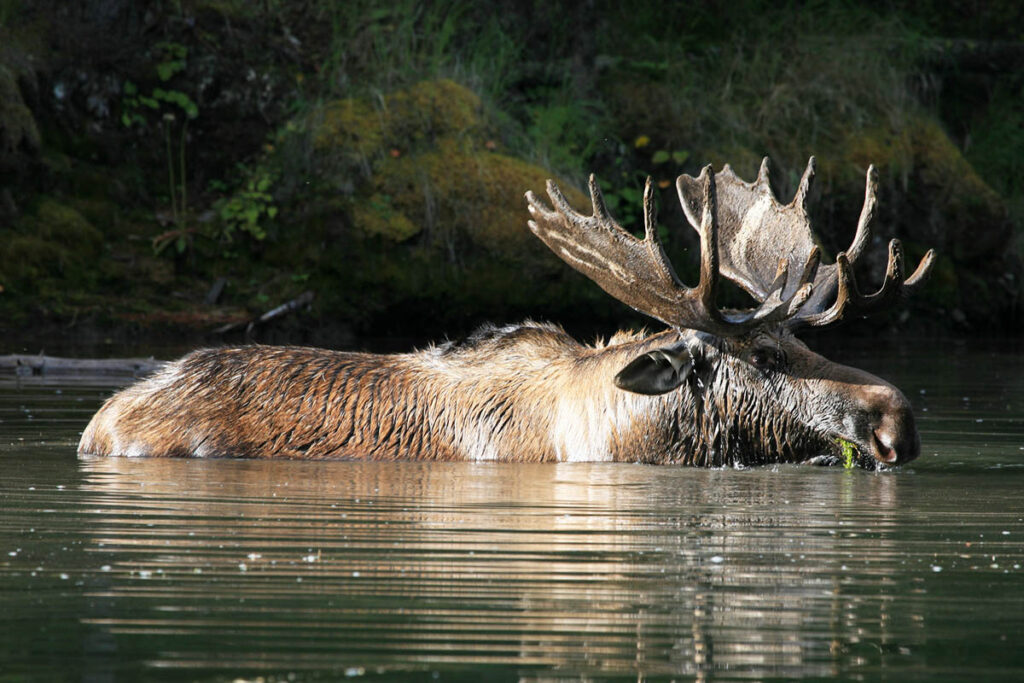Kananaskis Country Wildlife Viewing
Although the national parks get most of the attention from visitors to the Canadian Rockies, locals will tell you that Kananaskis Country is prime territory for wildlife viewing.
For descriptions of all wildlife species present in Kananaskis Country, visit our Kananaskis Country Nature Guide.
Aquatic Species
BEAVERS are common in low-elevation valleys, including the Kananaskis Valley and Elbow River Valley. Dawn and dusk are the best times to watch these intriguing creatures at work. There are some impressive dams along Sibbald Valley Road and below Gooseberry PRA Campground. Also present in the same wetlands are MINK and MUSKRAT.
Ungulates
Four species of deer inhabit Kananaskis Country. The large-eared MULE DEER is commonly seen around valley bottoms including Bow Valley Provincial Park. WHITE-TAILED DEER can be seen throughout Kananaskis Country. ELK is not particularly common but can be seen in Bow Valley Provincial Park and the Kananaskis Valley. Although MOOSE are also not common in the Canadian Rockies, they are relatively common in Kananaskis Country, most often seen around the two Kananaskis Lakes and near Spray Lakes.

Moose feeding on vegetation in a shallow pond.
In summer, MOUNTAIN GOATS browse in alpine meadows. A good place for goat-watching is the back of Rawson Lake. Unlike most of Kananaskis Country’s large mammals, these sure-footed creatures don’t migrate to lower elevations in winter but stay sheltered on rocky crags where wind and sun keep the vegetation snow free.
Often confused with the goat is the darker BIGHORN SHEEP. The horns on the males of this species are thick and often curl 360 degrees. Bighorns are common along Highway 40 through the Kananaskis Valley and a large swathe of the Sheep River Valley is set aside as Sheep River Provincial Park, protecting the winter range of hundreds of bighorn sheep.
Bears
Numbering around 80 within Kananaskis Country, BLACK BEARS are widespread and occasionally wander into campgrounds looking for food. They are most commonly seen along highways in spring, when they first come out of hibernation. GRIZZLY BEARS are occasionally seen in Spray Valley Provincial Park or the vicinity of Highwood Pass. For the most part, they remain in remote mountain valleys, and if they do see, smell, or hear you, they’ll generally move away.
Reclusive Residents
Several of the Kananaskis’s resident species keep a low profile, usually out of sight of humans. Populations of the shy and elusive LYNX fluctuate with that of their primary food source, the snowshoe hare. The largest of the big cats in the Canadian Rockies is the COUGAR (also called the mountain lion), a solitary carnivore that inhabits remote valleys. While not particularly common, COYOTES can be seen in cleared areas alongside the roads, usually at dawn and dusk.
Other Mammals
The PINE MARTEN is common but shy; look for them in subalpine forests. The SHORT-TAILED WEASEL—a relative of the marten—is also common, while the long-tailed weasel is rare. I’ve spotted them at Pocaterra Cirque. At higher elevations look for PIKAS in piles of fallen rock. HOARY MARMOTS live near the upper limits of vegetation growth, where their shrill warning whistles carry across the open meadows; Ptarmigan Cirque supports a healthy population of these noisy creatures.
Birds
The extensive tree cover in Kananaskis Country’s lower valleys hides many species of birds, making them seem less abundant than they are; over 260 species have been recorded. The two you’re most likely to see are the GRAY JAY and CLARK’S NUTCRACKER, which regularly joins picnickers for lunch. Also common are black-and-white MAGPIES, raucous RAVENS, and several species of DUCKS, which can be seen around low-elevation lakes.
At dusk, GREAT-HORNED OWLS swoop silently through the trees, their eerie call echoing through the forest. GOLDEN EAGLES and BALD EAGLES can be seen soaring high above the forests of Kananaskis Country, and OSPREYS nest along low-elevation rivers throughout Kananaskis Country.
Kananaskis Country Wildlife Photography Book
Even if you’re not interested in photography, the Canadian Rockies Wildlife Photography eBook, by renowned wildlife photographer Wayne Lynch, is a great resource for searching out local wildlife. It includes all the very best places to view wildlife in Kananaskis Country.
Wildlife Safety in Kananaskis Country
An abundance of wildlife is one of the biggest draws of Kananaskis Country. To help preserve this precious resource, obey fishing and hunting regulations and use common sense.
DO NOT FEED THE ANIMALS. Many animals may seem tame, but feeding them endangers yourself, the animal, and other visitors, as animals become aggressive when looking for handouts (even the smallest critters, such as squirrels).
STORE FOOD SAFELY. When camping, keep food in your vehicle or out of reach of animals. Just leaving it in a cooler isn’t good enough.
KEEP YOUR DISTANCE. Although it’s tempting to get close to wildlife for a better look or a photograph, it disturbs the animal and, in many cases, can be dangerous.
DRIVE CAREFULLY. The most common cause of premature death for larger mammals is being hit by vehicles.
